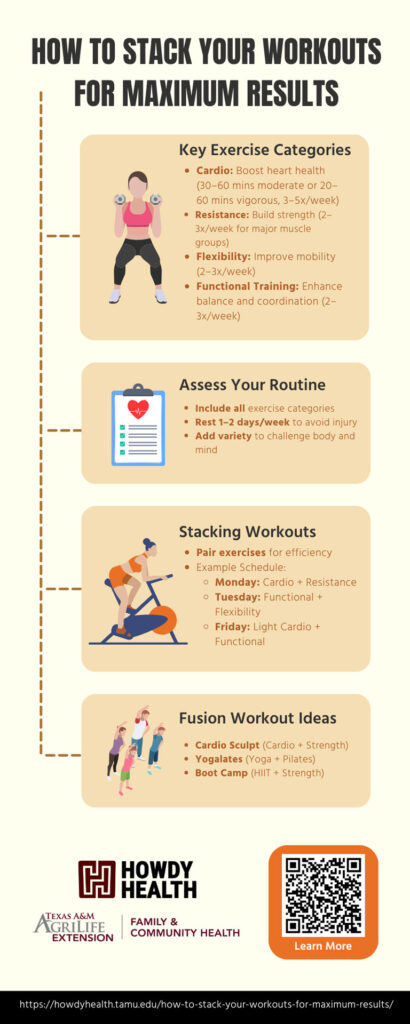Finding the perfect balance in your fitness routine can enhance your results, prevent overuse injuries, and keep things fresh and engaging. Stacking your workouts—combining different types of exercises—helps create a well-rounded, time-efficient fitness program. Here’s a simple, step-by-step guide to stacking your workouts, based on the guidelines from the American College of Sports Medicine (ACSM).
Step One: Understand the Key Exercise Categories
A balanced workout program incorporates four types of exercise. Here’s a breakdown:
1. Cardiorespiratory Exercise (Aerobic Activity)
- Purpose: Improves heart and lung health while burning calories.
- Recommendation:
- 30–60 minutes of moderate intensity, 5 days a week; or
- 20–60 minutes of vigorous intensity, 3 days a week.
- Examples:
- Walking
- Jogging
- Cycling
- Swimming
- Rowing
- Cardio dance
2. Resistance Exercise
- Purpose: Builds muscular strength and endurance.
- Recommendation: Target all major muscle groups 2–3 days per week.
- Examples:
- Weightlifting
- Bodyweight exercises
- Resistance bands
- Machine-based circuits.
3. Flexibility Exercises
- Purpose: Enhances joint mobility and prevents stiffness.
- Recommendation: Perform flexibility exercises 2–3 days a week.
- Examples:
- Yoga
- Stretching routines
- Foam rolling
4. Functional Fitness Training
- Purpose: Improves balance, coordination, agility, and fall prevention.
- Recommendation: Include 2–3 days per week.
- Examples:
- Balance training
- Tai Chi
- Functional movement drills
Step Two: Assess Your Current Workout Routine
Take a moment to evaluate your existing schedule. Ask yourself:
- Am I missing any exercise categories?
Example: If you walk or run most days, add flexibility, strength, and functional exercises 2–3 days to balance your routine. - Am I overworking certain muscles?
Avoid doing the same activity day after day without rest. Rest days (or light activity days) are essential for recovery. Not allowing your body to rest and recover can lead to fatigue and injury. Take 1–2 recovery days (with no formal activity or only light activity) per week to allow your body to heal and prevent burnout. - Am I getting enough variety?
Mixing up your routine not only challenges your body in new ways but also your mind – and it keeps workouts interesting. For instance, if you swim 5 days a week, consider substituting one session with cycling or functional fitness. If you walk most days, try adding a few flexibility exercises at the end of your walk 2 days a week. If you go to the gym to lift weights 3 days a week, add some cardio on the elliptical or rower, and/or do some functional exercises to challenge your balance and stability.
Step Three: Stack Your Workouts
Stacking means combining complementary exercises to create a balanced and efficient workout routine. You can maximize your time by combining the types of exercises you need with exercises you already do. Here’s how to do it:
1. Combine Categories
- Pair aerobic fitness workouts (e.g., walking, running, or cycling) with other categories – resistance, flexibility., and functional.
- Example Weekly Plan by Category:
- Monday: Cardio + Resistance
- Tuesday: Functional Fitness + Flexibility
- Wednesday: Cardio
- Thursday: Resistance + Flexibility
- Friday: Light Cardio + Functional Fitness
- Saturday: Rest
- Sunday: Cardio/Resistance Combo
2. Try Fusion Workouts
Fusion workouts naturally stack multiple categories. These are fun and time-efficient options for busy schedules.
- Examples:
- Cardio sculpt (cardio + strength)
- Yogalates (yoga + Pilates)
- Boot camp (high-intensity cardio + strength)
- High-intensity interval training (HIIT)
3. Sample Weekly Plan by Activity
If you prefer specific activities, create a routine like this:
- Monday: Walk/Run + 10 resistance exercises (8–12 reps, 2 sets)
- Tuesday: Balance training + Stretching
- Wednesday: Indoor cycling class
- Thursday: Walk/Run + Resistance training
- Friday: Elliptical + Yoga
- Saturday: Rest
- Sunday: Boot camp class
Pro Tips
- Set Clear Goals: Whether you want to improve strength, endurance, flexibility, agility, balance, or speed, you can tailor your routine to fit those goals.
- Seek Expert Guidance: A physical therapist, exercise physiologist, or certified trainer can help design a safe and effective plan tailored to your needs. If you have any medical or health concerns, consult your doctor or health care provider.
By stacking your workouts, you’ll enjoy a well-rounded routine that targets all aspects of fitness, keeps you motivated, and delivers better results. Get started today and watch your progress take off! Want some motivation to get moving? Try one of our fitness programs.
Infographic
Download the PDF or share the image below to help others learn more about how to stack your workouts for maximum results.
How to Stack Your Workouts for Maximum Results – Infographic (pdf)
Reference
DeSimone, Grace T. B.A., ACSM-CPT, ACSM-GEI. SHAREABLE RESOURCE: Stack Your Workouts. ACSM’s Health & Fitness Journal 27(2):p 4-5, 3/4 2023. | DOI: 10.1249/FIT.0000000000000838. Accessed January 30, 2025. https://journals.lww.com/acsm-healthfitness/fulltext/2023/03000/shareable_resource__stack_your_workouts.3.aspx.



